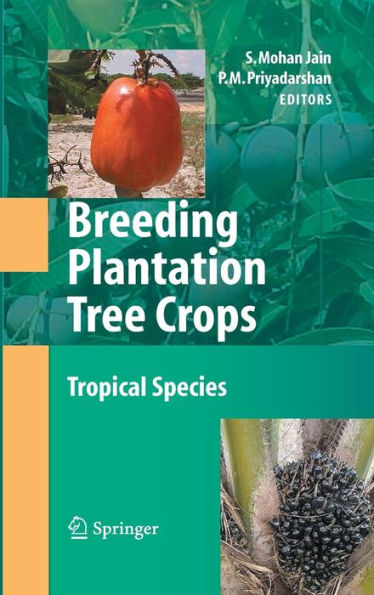Breeding Plantation Tree Crops: Tropical Species
Tree species are indispensable to support human life. Due to their long life cycle and environmental sensitivity, breeding trees to suit day-to-day human needs is a formidable challenge. Whether they are edible or industrial crops, improving yield under optimal, sub-optimal and marginal areas calls for unified efforts from the s- entistsaroundtheworld. While the uniqueness of coconutaskalpavriksha (Sanskr- meaning tree-of-life) marks its presence in every continent from Far East to South America, tree crops like cocoa, oil palm, rubber, apple, peach, grapes and walnut prove their environmental sensitivity towards tropical, sub-tropical and temperate climates. Desert climate is quintessential for date palm. Thus, from soft drinks to breweries to beverages to oil to tyres, the value addition offers a spectrum of pr- ucts to human kind, enriched with nutritional, environmental, financial, social and trade related attributes. Taxonomically, tree crops do not confine to a few families, but spread across a section of genera, an attribute so unique that contributes immensely to genetic biodiversity even while cultivated at the commercial scale. Many of these species influence other—ora to nurture in their vicinity, thus ensuring their integrity in p- serving the genetic biodiversity. While wheat, rice, maize, barley, soybean, cassava andbananamakeup the major food staples, many fruit tree species contribute greatly tonutritionalenrichment inhumandiet. The edible part of the sespecies is the source of several nutrients that makes additives for the daily diet of humans, for example, vitamins, sugars, aromas and—avour compounds, and raw material for food proce- ing industries. Tree crops face an array of agronomic and horticultural problems in propagation, yield, appearance, quality, diseases and pest control, abiotic stresses and poor shelf-life.
1101498648
Breeding Plantation Tree Crops: Tropical Species
Tree species are indispensable to support human life. Due to their long life cycle and environmental sensitivity, breeding trees to suit day-to-day human needs is a formidable challenge. Whether they are edible or industrial crops, improving yield under optimal, sub-optimal and marginal areas calls for unified efforts from the s- entistsaroundtheworld. While the uniqueness of coconutaskalpavriksha (Sanskr- meaning tree-of-life) marks its presence in every continent from Far East to South America, tree crops like cocoa, oil palm, rubber, apple, peach, grapes and walnut prove their environmental sensitivity towards tropical, sub-tropical and temperate climates. Desert climate is quintessential for date palm. Thus, from soft drinks to breweries to beverages to oil to tyres, the value addition offers a spectrum of pr- ucts to human kind, enriched with nutritional, environmental, financial, social and trade related attributes. Taxonomically, tree crops do not confine to a few families, but spread across a section of genera, an attribute so unique that contributes immensely to genetic biodiversity even while cultivated at the commercial scale. Many of these species influence other—ora to nurture in their vicinity, thus ensuring their integrity in p- serving the genetic biodiversity. While wheat, rice, maize, barley, soybean, cassava andbananamakeup the major food staples, many fruit tree species contribute greatly tonutritionalenrichment inhumandiet. The edible part of the sespecies is the source of several nutrients that makes additives for the daily diet of humans, for example, vitamins, sugars, aromas and—avour compounds, and raw material for food proce- ing industries. Tree crops face an array of agronomic and horticultural problems in propagation, yield, appearance, quality, diseases and pest control, abiotic stresses and poor shelf-life.
379.99
In Stock
5
1

Breeding Plantation Tree Crops: Tropical Species
654
Breeding Plantation Tree Crops: Tropical Species
654Hardcover(2009)
$379.99
379.99
In Stock

Product Details
| ISBN-13: | 9780387711997 |
|---|---|
| Publisher: | Springer New York |
| Publication date: | 10/23/2008 |
| Edition description: | 2009 |
| Pages: | 654 |
| Product dimensions: | 6.40(w) x 9.40(h) x 1.40(d) |
From the B&N Reads Blog
